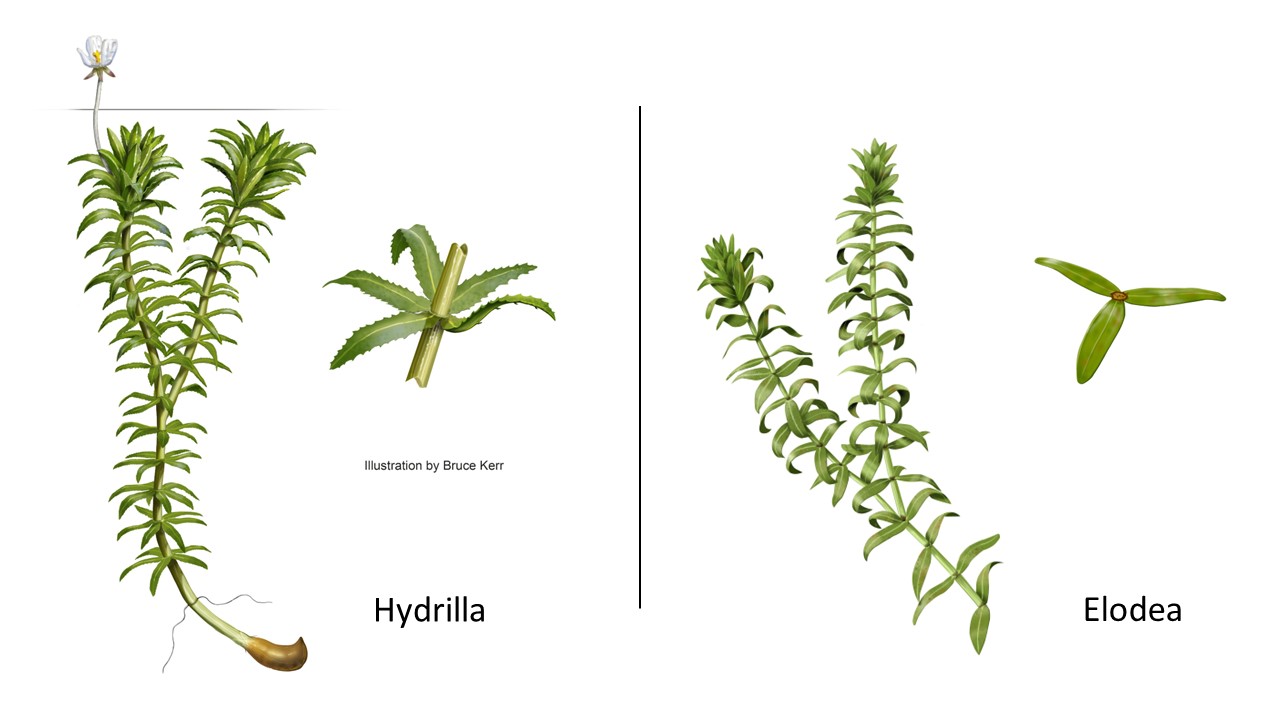Invasive hydrilla, a “monster aquatic weed,” discovered for the first time in Michigan waters
Here’s how to prevent the spread of invasive hydrilla.

The Michigan Invasive Species Program (MISP) announced Monday that hydrilla (Hydrilla verticillata), a highly invasive aquatic plant, has been discovered in Michigan waters for the first time. Two small patches were confirmed in adjacent private ponds on residential property in Berrien Springs in southwest Michigan. Michigan State University Extension assisted the Michigan Department of Environment, Great Lakes, and Energy (EGLE) staff by confirming the identification of hydrilla and participating in the survey effort to determine the extent of this new invasion.
What is hydrilla?
Hydrilla is a highly invasive aquatic plant and is recognized as one of the most difficult invasive species to control in the United States. Because it grows underwater, it often spreads undetected after it invades a water body. According to MISP, hydrilla can grow in lakes, rivers, springs, marshes, or ditches, and can tolerate low light and a variety of nutrient conditions.
Hydrilla can spread by fragments as well as by seed, overwintering buds called turions, and underground tubers. Because of this, hydrilla can spread very rapidly – even more so than Eurasian watermilfoil, another highly invasive aquatic plant that has been causing problems in Michigan waters for decades. Once established, hydrilla can grow rapidly into thick mats that crowd out native species, severely alter aquatic habitat, and disrupt aquatic recreation like boating and fishing.
Hydrilla can easily be confused with Canadian waterweed (Elodea canadensis), a native and beneficial plant of Michigan waters. Both plants have small, pointed leaves whorled around long stems. However, hydrilla leaves are typically found in whorls of 4-8 (typically 5) around the stem and are toothed along the edges and midvein, while waterweed leaves are typically in whorls of 2-4 (typically 3) and teeth, if visible at all, are very small along the edges.

What can I do?
Michigan State University Extension’s Center for Lakes and Streams offers several resources and programs to help defend Michigan’s waters from hydrilla.
Don’t let it loose
RIPPLE (Reduce Invasive Pet and Plant Escapes) reminds water gardeners and aquarists that exotic plants, fish, and other animals purchased at retail stores such as pet shops and garden stores must be kept contained and never released into natural water bodies. It is likely that the hydrilla invasion was the result of planting non-native ornamental aquatic plants in the private ponds where it was discovered. Unwanted plants and animals are commonly found “hitchhiking” in containers of aquatic ornamentals. RIPPLE offers these suggestions:
- Never release an aquatic plant or animal into a natural waterway that was purchased at a retail store (lake, river, storm drains, retention ponds).
- Give or trade unwanted fish or plants with another hobbyist, retailer, environmental learning center, aquarium or zoo. Use the RIPPLE Fresh Water Protector network map to find a participating retailer nearest you.
- Unwanted hitchhiking species are common. Inspect and rinse any new plants to rid them of seeds, plant fragments, snails and fish.
- Build water gardens away from other waters. Check out the MSU Extension Smart Gardening fact sheet on water gardening to learn more.
- Contact a veterinarian or pet retailer for guidance on humane disposal of animals.
Clean, drain, and dry
Hydrilla can easily spread from one water body to another if attached to boats, trailers, and other recreational gear. The Clean Boats, Clean Waters (CBCW) program has a variety of resources, assistance, and small grants for communities who want to support boater education. CBCW offers the following recommendations to all boaters and water recreationists:
- Clean boats, trailers and equipment.
- Drain live wells, bilges, ballast tanks, and all water by pulling drain plugs.
- Dry boats and equipment.
- Dispose of unwanted bait in the trash.
Identify and report
Knowing how to identify hydrilla is imperative to slow the spread of this invasive plant. MSU Extension leads Michigan’s statewide volunteer lake and stream monitoring program, the Michigan Clean Water Corps (MiCorps). For over 20 years, MiCorps volunteers participating in the Exotic Aquatic Plant Watch have been trained to identify and survey Michigan lakes for hydrilla and other invasive species. The program is open to anyone interested in getting involved.
Other useful resources for learning to identify and report invasive species like hydrilla include the Midwest Invasive Species Information Network (MISIN) and the Michigan Invasive Species Program. Any suspicious aquatic plants should be reported as soon as possible to EGLE-WRD-AIP@Michigan.gov. Include close-up photos and provide the location of the detection in your report.



 Print
Print Email
Email




